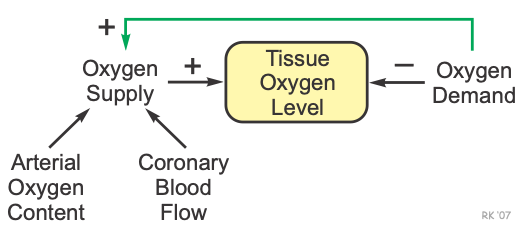Myocardial Oxygen Balance
 Myocardial oxygen balance is determined by the ratio of oxygen supply to oxygen demand as shown in the figure. Increasing oxygen supply by increasing either arterial oxygen content or coronary blood flow leads to an increase in tissue oxygen levels (usually measured as the partial pressure of oxygen, PO2). Increasing oxygen demand alone (i.e., myocardial oxygen consumption) decreases tissue oxygen levels. Normally, when oxygen demand increases, there is a proportionate increase in coronary blood flow and oxygen supply (green arrow), so that tissue oxygen levels are maintained during times of increased oxygen demand. This increase in blood flow is performed by local regulatory mechanisms. This tight coupling between oxygen demand and coronary blood flow is impaired in coronary artery disease because oxygen supply is limited by vascular stenosis. If the oxygen supply/demand ratio is reduced either by a decrease in oxygen delivery relative to demand, or by an increase in demand relative to supply, then tissue hypoxia results.
Myocardial oxygen balance is determined by the ratio of oxygen supply to oxygen demand as shown in the figure. Increasing oxygen supply by increasing either arterial oxygen content or coronary blood flow leads to an increase in tissue oxygen levels (usually measured as the partial pressure of oxygen, PO2). Increasing oxygen demand alone (i.e., myocardial oxygen consumption) decreases tissue oxygen levels. Normally, when oxygen demand increases, there is a proportionate increase in coronary blood flow and oxygen supply (green arrow), so that tissue oxygen levels are maintained during times of increased oxygen demand. This increase in blood flow is performed by local regulatory mechanisms. This tight coupling between oxygen demand and coronary blood flow is impaired in coronary artery disease because oxygen supply is limited by vascular stenosis. If the oxygen supply/demand ratio is reduced either by a decrease in oxygen delivery relative to demand, or by an increase in demand relative to supply, then tissue hypoxia results.
A reduced oxygen supply/demand ratio causes chest pain (angina) associated with coronary artery disease. These patients are treated with antianginal drugs such as beta-blockers, calcium-channel blockers, nitrodilators that improve this ratio.
Revised 01/30/2023

 Cardiovascular Physiology Concepts, 3rd edition textbook, Published by Wolters Kluwer (2021)
Cardiovascular Physiology Concepts, 3rd edition textbook, Published by Wolters Kluwer (2021) Normal and Abnormal Blood Pressure, published by Richard E. Klabunde (2013)
Normal and Abnormal Blood Pressure, published by Richard E. Klabunde (2013)